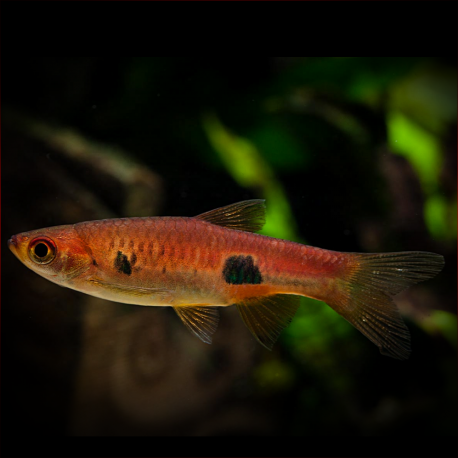More info
Datasheet
| Minimum Tank Size | 255 litres / 67.36 US gallons |
| Maximum Size | 10.2cm / 4.02inches |
| Temperature | 23°C / 73.40°F - 28°C / 82.40°F |
| Hardness | 2-10ºdH |
| pH | 5.0-7.5 |
Behaviour:
This species of clown rasbora is known for its peaceful nature, making it an ideal addition to a community tank. It is recommended to house at least 8-10 specimens together to prevent any potential aggression issues, allowing the males to display their best colors as they compete for female attention. Keeping them in a decent-sized group not only reduces their nervousness but also creates a more natural and visually appealing display within the aquarium.
Feeding and Diet:
The clown rasbora primarily feeds on invertebrates in its natural habitat but readily accepts a varied diet in captivity. To enhance their coloration and overall condition, it is advised to offer live and frozen foods such as bloodworms, Daphnia, and Artemia, alongside high-quality dried flakes and granules. Maintaining a diverse diet ensures the proper nutrition and health of these fish in an aquarium setting.
Reproduction & Dimorphism:
As with many small cyprinids, the clown rasbora is an egg-scattering species that spawns continuously with no parental care. Breeders can set up separate breeding containers within a mature aquarium to increase fry survival rates. Mature females are distinguishable by their rounder bellies and slightly larger size compared to males, aiding in sexing these fish during breeding activities.
Habitat and Distribution:
The clown rasbora, scientifically known as Rasbora kalochroma, is native to Peninsular Malaysia and the Greater Sunda Islands of Borneo and Sumatra. Inhabiting blackwater streams of ancient forest peat swamps, these fish thrive in soft, acidic waters characterized by brownish coloration due to organic decomposition. Unfortunately, their natural habitat is increasingly threatened by human activities like deforestation and agriculture, emphasizing the importance of conservation efforts.
Aquarium Setup:
Setting up an aquarium for clown rasboras involves creating a well-planted environment with a dark substrate to accentuate their colors. Driftwood, branches, and dried leaf litter can be added to mimic their natural habitat and provide ample hiding spots. To simulate blackwater conditions, utilizing aquarium-safe peat or genuine peat fiber is recommended. Maintaining dim lighting, adding suitable plant species, and incorporating floating vegetation for light diffusion are also crucial for the well-being of these fish. A secure cover is necessary as rasboras are known to jump.
Please note that this content has been crafted based on the information provided and tailored for educational purposes.

